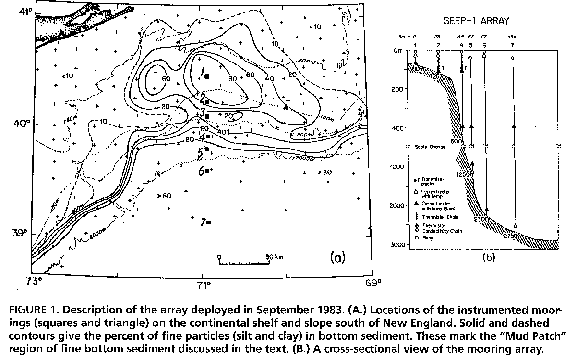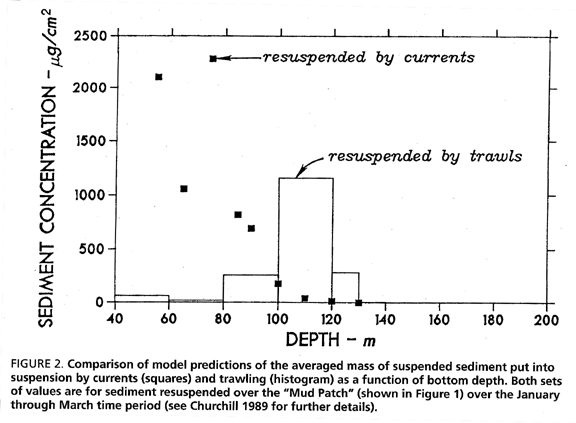|
My interest in this topic began more than a decade ago, when I was involved in a study of sediment transport from the New England continental shelf to the deep ocean. This study was motivated in part by an interest in contaminant movement over continental shelves. Fine sediments carry most of the contaminants that are introduced into the coastal ocean. Another interest of the study was the movement of organic carbon off the shelf. A significant fraction of the particulate organic carbon produced in the coastal ocean by photosynthesis is bound in fine particles. Because this carbon is largely derived from dissolved CO2, a greenhouse gas, carbon-carrying particles can be thought of as tiny players in the global warming game. They can act to mitigate global warming if carried off the shelf and buried in deep-sea sediments, in essence, permanently removing their carbon from the atmosphere. As part of the study, my colleagues and I deployed instrumented moorings along a line extending across the New England shelf and down the continental slope into the deep ocean. On the shelf, the line was roughly centered within an area of fine grain sediment commonly referred to as the Mud Patch (Figure 1). Records from optical particle sensors revealed near bottom patches of high turbidity that occurred during calm conditions and thus could not have been the result of sediment resuspension by bottom currents (Churchill et A 1988). Suspecting trawling as a resuspension agent, I obtained records of trawling activity in the region of our moored array from the National Marine Fisheries Service (NMFS). These revealed that intense trawling often occurred near our particle sensors at times when the sensors detected high turbidity and companion sensor records showed weak currents and wave action. Similar findings have been reported by other researchers (Butman and Noble 1979; Wardle 1983; Bohlen and Winnick 1984). An unpublished but dramatic piece of anecdotal evidence was offered by the record of an optical sensor which showed a sharp peak in turbidity just before the sensor was hit by a trawl.  To assess the influence of trawling on shelf sediment movement, I developed a model to calculate the mean concentration of sediment put into suspension by trawling. This model utilized rates of sediment resuspension by trawls derived from the data collected in a near-shore study by Schubel et al. U 978). The model also required estimates of sediment settling and NMFS records of trawling activity in the region of interest. To estimate the mean concentration of sediment put into suspension by currents, I modified a model developed by Lyne et al. (1990), which utilized measurements of near-bottom currents, surface wave motions, and near-bottom particle concentrations. Sample results from these models, comparing mean wintertime concentrations of trawl- and current resuspended sediments over the Mud Patch, show that the overall impact of trawling on sediment resuspension is a strong function of bottom depth (Figure 2). Currents are indicated as the dominant wintertime resuspension mechanism over the inner and middle shelf. Over the outer shelf, however, trawling is indicated as the principal agent effecting sediment resuspension. Clearly, these results, derived from data-driven models, should be viewed with a healthy measure of skepticism. Nevertheless, they strongly suggest that trawling can play an important (and in some regions, a dominant) role in raising bottom material into the water column.  Let us now consider the potential effects of sediment resuspension by trawling. One obvious effect is initiating horizontal movement of solid particles by exposing them to ocean currents. As noted above, the movement of fine particles off the shelf is of particular interest. Based solely on the decline in sediment resuspension frequency with increasing depth off the shelf (Figure 2), one would expect a mean transport of sediment from the outer shelf to the slope. This occurs because some portion of the sediment resuspended over the outer shelf will eventually settle out on the slope where resuspension events are rare (Csanady et al. 1988). A result is permanent (or at least quasi-permanent) removal of contaminants and organic carbon from the shelf environment. Calculations using current meter data and the models discussed above suggest that trawling is an important mechanism in initiating this type of off-shelf sediment transport from the Mud Patch (Churchill 1989). From the viewpoint of maintaining a fishery, one of the most important potential effects of resuspension by trawling is delivering nutrients from the bottom into the euphoric zone, where photosynthesis occurs. In many areas of the continental shelf off the U.S. east coast, roughly half the nutrient supply for primary production is derived from upward transfer from sediments. Resuspension by trawling could significantly enhance the euphotic zone nutrient supply and primary production. However, the manner in which this occurs could produce side effects. For example, a significant nutrient input from trawl resuspension could alter the character of the lower food chain, favoring species which are better suited to pulsed nutrient supply. Trawling could also influence the manner in which nutrients are regenerated in bottom sediment. An analogy can be made with tilling of an agricultural plot (Mayer et A 199 1). Nutrient regeneration within soils of untilled plots tends to be dominated by fungi. By contrast, in tilled fields, bacteria become a more important factor in nutrient regeneration. While fungi are not important in nutrient cycling within the ocean, trawling could produce a similar "downsizing" of the organisms effecting nutrient regeneration in marine sediments, reducing the importance of higher organisms (protozoans or animals) and increasing the role of bacteria. Currently, however, there is little quantitative information on how sediment overturn by trawling, or other types of bottom fishing, alters bottom nutrient regeneration. While it is clear that sediment resuspension by trawling likely impacts the shelf environment in numerous ways, understanding of the details of these is sketchy at best. Filling in the gaps in this understanding will require dedicated field studies. These must be done in the regions of interest, for it is clear that measurements related to sediment resuspension in shallow regions with sandy sediment are not likely to be applicable to deep regions with fine sediment. From a sediment dynamics viewpoint, the most fundamental issues requiring study are the effects of trawling on suspended sediment load and sediment transport. Quantifying these effects requires determining the rate at which trawls resuspend sediment (i.e., the mass of sediment put into suspension per unit track length), the height of the sediment plumes generated by trawling and the time required for these to settle. These properties can be determined by measuring sediment concentration across a sediment plume segment at various times after its generation by a trawl. These measurements would likely require combining water sample collection with acoustical and optical sampling of sediment concentration. Following a plume segment will be problematical. It could be accomplished by marking the plume with drifters and dye and using shipboard velocity profile data (obtained with an acoustic Doppler current profiler) to further guide the plume tracking. Investigating the effects of trawling on nutrient supply and on the resulting biological response will require still more involved techniques. My background as a physical oceanographer leaves me woefully unqualified to offer suggestions as to how these studies should be designed. Nonetheless, it is clear that, regardless of the design specifics, certain issues must be addressed. One is the effect of trawling in supplying the euphotic zone with nutrients. Does trawling significantly enhance nutrient levels in the euphotic zone? Is primary productivity appreciably increased? Does the pulsed nutrient supply by trawling benefit some species over others. If so, what is the ultimate effect on the ecosystem? Another issue of importance is the effect of trawling on nutrient regeneration in bottom sediments. Is the rate of nutrient regeneration significantly changed by trawl action? If so, how does this affect the benthic community? Ideally, field studies on the effects of trawling should be directed at developing models which could be used to assess, with reasonable confidence, the impact of sediment resuspension by trawling on a specified ecosystem. However, whatever its goal, my experience is that any study on the effects of trawling is best done with input and cooperation of the fishing community and without a priori assumptions as to whether bottom fishing is harmful or beneficial to the marine environment. Acknowledgements I extend my appreciation to Dr. Larry Mayer of the University of Maine for his critical reading of the manuscript. REFERENCES Bohlen, W E and K. B. Winnick. 1984. Observations of near-bottom suspended matter concentration at the FVT site central Long Island Sound predisposal material area; 18 April 1983-29 June 1983. Prepared for Science Applications International Corporation. Newport, Rhode Island. 100 pp. Butman, B. and M. Noble. 1979. Observations of currents and bottom sediment mobility in the offshore middle Atlantic Bight, 1976-1977. Pp. 1-46 in H.J. Kriebel, ed. Middle Atlantic Outer Continental Shelf Environmental Studies, Vol. III: Geologic Studies. Virginia Institute of Marine Science, Gloucester Point, VA. Churchill, J. H., P. E. Biscaye and F. Aikman 111. 1988. The character and motion of suspended particulate matter over the shelf-edge and upper slope off Cape Cod. Cont. Shelf Res. 8:789-809. Churchill, J. H. 1989. The effect of commercial trawling on sediment resuspension and transport over the Middle Atlantic Bight continental shelf. Cont. Shelf Res. 9:841864. Csanady, G. T., J. H. Churchill and B. Butman. 1988. Near-bottom currents over the continental slope in the Mid-Atlantic Bight. Cont. Shelf Res. 8:653-671. Korotkow, W K. and W N. Martyschewski. 1977. Results obtained by use of the underwater device "Atlant" for the study of how fish behave and how trawl net operate. Fischerei-Forschung Schriftentreihe 15:39-43. Lyne, V. D., B. Butman and W D. Grant. 1990. Sediment movement along the U.S. east coast continental shelf-11. Modeling suspended sediment concentration and transport rate during storms. Cont. Shelf Res. 10:429-460. Main, J. and G. I. Sangster. 1981. A study of sand clouds produced by trawl boards and their possible effect on fish capture. Scottish Fisheries Research Report No. 20. Dept of Agriculture and Fisheries for Scotland. 19 pp. Main, J. and G. I. Sangster. 1983. Fish reactions to trawl gear-a study comparing light and heavy groundgear. Scottish Fisheries Research Report No. 27. Dept of Agriculture and Fisheries for Scotland. 17 pp Mayer, L. M., D. E Schick, R. H. Findlay and D. L. Rice. 199 1. Effects of commercial dragging on sedimentary organic matter. Mar. Environ. Res. 31:249-261. Schubel, J. R., H. H. Carter, R. E. Wilson, W M. Wise, M. G. Heaton and M. G. Gross. 1978. Field investigations of the nature, degree and extent of turbidity generated by open-water pipeline disposal operations. Technical Report D78-30. Marine Sciences Research Center, State University of New York, Stony Brook, NY 245 pp. Wardle, C. S. 1983. Fish reactions to towed fishing gears. Pp. 167-195 in A. G. MacDonald and I. G. Priede, eds. Experimental Biology at Sea. Academic Press, London. |